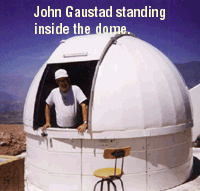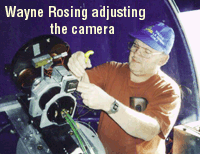

The CCD camera, from SpectraSource, Inc., contains a 1024 x 1024 TI chip with 12-micron pixels. It is thermoelectrically cooled. The sky is imaged onto the chip with a 50-mm f.l. Canon lens operated at f/1.6, yielding a field of view of 13º x 13º and a scale of 48"/pixel. A filter wheel mounted in front of the lens contains, for the SHASSA survey, an H-alpha filter of 3-nm bandwidth and a dual-band notch filter which excludes H-alpha but transmits two 6-nm bands of continuum radiation on either side of H-alpha. Similar filters, line and continuum, are used for other projects. The filter wheel is encased in styrofoam and maintained at constant temperature to provide wavelength stability of the filters.
The system is controlled by two PCs running programs written in Visual Basic under Windows 98. One of the computers positions the telescope and dome while the other operates the camera, schedules the observations, and runs the ftp and email communication links. A log of the night's operations and sample images are sent to the PI each morning via email and ftp, but the full data set is recorded on disk and then transferred to magnetic tape during the day. We can inquire of the status of the robot via email, and make changes in the program or observing schedule via ftp. But we do not operate the camera in real time--it is a true robot. The robot has its own weather station and will not attempt observations if humidity or wind conditions exceed safe limits, but as an extra precaution it also asks permission (via email) of the 4-meter telescope operator before opening the dome. The operator can also close the dome via email command. The only other human intervention, during normal operations, is for weekly tape-changing and preventive maintenance.